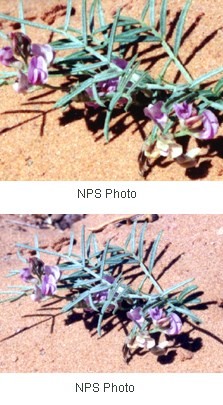
Astragalus ceramicus var. ceramicus Family: Fabaceae (A Utah Flora – Leguminosae) – Pea Family Perennial herbs from a taproot; 1.2” to 1.3' (3 to 40 cm) tall Leaves: alternate; compound; 1 to 13 leaflets; 0.08” to 0.68” (2 to 17 cm) long Flowers: 5 purple, pink or rarely white petals (a banner, 2 wings and 2 keels); keel shorter than the wings; 5 toothed sepals; 5-10 stamens, 1 pistil; bisexual; flowers 0.25” to 0.38” (6.3 to 9.5 mm) long Pollinators: other Astragalus species are pollinated by bees, moths and butterflies Fruits: legume Blooms in Arches National Park: April, May Habitat in Arches National Park: sandy soils in desert shrub, grassland, riparian and pinyon-juniper communities Location seen: park road and Delicate Arch road, outside Arches National Park in Grandstaff Canyon Other: The genus name, “Astragalus”, is the Greek name for “legume”, and may be derived from “astragalos” which means “ankle bone” referring to the shape of the leaves or the pods. The species name, “ceramicus”, means “pottery-like” and refers to the seedpod's appearance. This family is ranked second to grasses in importance to people because species can fix nitrogen. However, some species, e.g., locoweeds and milkvetches, are poisonous due to selenium abstracted from the soil. |
Last updated: April 29, 2025
